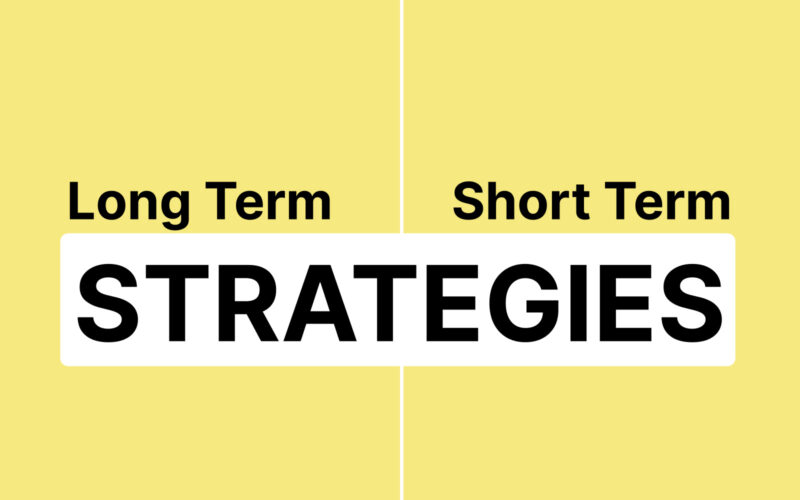In the realm of investments, the battle between long-term and short-term strategies continues to captivate the minds of both seasoned investors and newcomers alike. Choosing the right approach can make all the difference in achieving our financial goals.
In this blog, we will explore the fundamental aspects that distinguish long-term and short-term investment strategies. Each path offers a unique set of rewards and challenges, catering to different risk appetites and time horizons.
Difference Between Long-Term vs Short-Term Investment Strategies
| Aspect | Long-Term Investment Strategy | Short-Term Investment Strategy |
| Time Horizon | Typically years to decades | Typically days to months |
| Investment Duration | Buy and hold for extended periods | Frequent buying and selling (trading) |
| Risk Tolerance | Generally lower risk due to long time horizon | Higher risk due to short time horizon |
| Market Volatility | Tends to withstand market fluctuations | More susceptible to market volatility and noise |
| Investment Focus | Fundamental analysis of assets and companies | Technical analysis, short-term market trends |
| Returns Expectation | Potential for higher returns over time | Seeking quick gains and smaller profits |
| Psychological Impact | Less affected by short-term market fluctuations | More susceptible to emotional trading decisions |
| Portfolio Diversity | Diverse asset allocation to manage risk and growth | Limited diversification due to frequent trading |
| Tax Implications | May have favorable tax treatment on long-term gains | Often subject to higher short-term capital gains tax rates |
| Time Commitment | Requires patience and discipline | Demands constant monitoring and quick decision-making |
| Suitability | Suited for long-term financial goals and retirement plans | Appropriate for opportunistic traders and active investors |
Understanding Long-Term Investments and Short-Term Investments
Long-Term Investment Strategy
| Aspect | Explanation |
| Time Horizon | Long-term investments involve holding assets for an extended period, typically several years or even decades. The focus is on capitalizing on long-term market trends and economic growth. This strategy is suitable for building wealth gradually and achieving long-term financial goals like retirement planning or funding education. |
| Investment Duration | Investors adopting a long-term approach buy and hold their investments for the long haul. They are less concerned about short-term market fluctuations and aim to benefit from compounding returns over time. The idea is to stay invested in the market and avoid making frequent changes to the portfolio. |
| Risk Tolerance | Long-term investors often have a lower risk tolerance since they are focused on long-term goals. They understand that markets go through ups and downs, and they are willing to weather temporary market volatility for the potential of higher returns in the future. |
| Market Volatility | Long-term investments are designed to withstand market fluctuations. Investors are less concerned about short-term price movements and focus on the overall growth potential of their assets. They believe that, over time, the market tends to recover and deliver positive returns. |
| Investment Focus | The long-term strategy involves fundamental analysis of assets and companies. Investors carefully evaluate the financial health, growth prospects, and competitive advantages of the companies they invest in. The focus is on selecting solid, stable businesses with sustainable growth potential. |
| Returns Expectation | Long-term investors aim for higher returns over time. They understand that markets can be volatile in the short run, but historically, long-term investments have the potential to outperform short-term ones due to the power of compounding. |
| Psychological Impact | Long-term investors are less affected by short-term market fluctuations and noise. They tend to make investment decisions based on thorough research and a long-term perspective rather than reacting to short-term market movements. |
| Portfolio Diversity | Long-term investors emphasize diversification to manage risk. They spread their investments across different asset classes, industries, and geographies. A diversified portfolio is believed to reduce the impact of a downturn in any single investment. |
| Tax Implications | Long-term investments may have favorable tax treatment in some countries. For instance, long-term capital gains tax rates can be lower than short-term rates. This tax advantage can potentially enhance overall returns for long-term investors. |
| Time Commitment | The long-term strategy requires patience and discipline. Investors are not constantly monitoring their portfolio, making fewer transactions and adjustments. They stay focused on their long-term goals and avoid making impulsive decisions based on short-term market movements. |
| Suitability | This strategy is well-suited for individuals with long-term financial goals such as retirement planning, building wealth for future generations, or saving for major life events. It is considered a prudent approach for those who can afford to wait for their investments to mature. |
Short-Term Investment Strategy
| Aspect | Explanation |
| Time Horizon | Short-term investments involve holding assets for brief periods, ranging from days to months. The goal is to capitalize on immediate market fluctuations or short-lived opportunities. This strategy is suitable for investors seeking quick gains or those looking to profit from short-term market movements. |
| Investment Duration | Short-term investors engage in frequent buying and selling of assets, also known as trading. They seek to exploit short-term market trends and may execute multiple transactions within a short span to maximize profits. |
| Risk Tolerance | Short-term investors often have a higher risk tolerance, as they accept the potential for larger price swings in pursuit of quick profits. They may also be comfortable taking on leverage to amplify their gains (though this also increases risk). |
| Market Volatility | Short-term investments are more susceptible to market volatility and noise. Investors must closely monitor market trends and news, as short-term price movements can be influenced by various factors and may not necessarily reflect the underlying fundamentals of an asset. |
| Investment Focus | The short-term strategy often relies on technical analysis and short-term market trends. Investors use charts, patterns, and trading indicators to make buy and sell decisions based on short-term price movements rather than underlying fundamentals. |
| Returns Expectation | Short-term investors seek quick gains and aim to profit from short-term price fluctuations. They may be content with smaller, incremental profits achieved through frequent trading rather than waiting for larger, but potentially slower, long-term returns. |
| Psychological Impact | Short-term investing can be emotionally demanding. Investors must make rapid decisions based on short-term price movements, leading to higher stress levels and increased susceptibility to emotional biases that may impact their judgment. |
| Portfolio Diversity | Short-term investors may have limited portfolio diversity, especially those focusing on specific market sectors or assets. Their portfolios may be concentrated in assets currently performing well in the short term. |
| Tax Implications | Short-term capital gains are typically subject to higher tax rates compared to long-term capital gains in many countries. Frequent trading can lead to higher tax liabilities, potentially reducing overall returns for short-term investors. |
| Time Commitment | Short-term investing requires constant monitoring and quick decision-making. Investors must be actively engaged with the market and prepared to execute trades promptly in response to market changes. |
| Suitability | This strategy is more suitable for experienced investors or traders who are comfortable with taking on higher risk and who have the time, knowledge, and dedication to closely track the markets and execute frequent trades for short-term gains. |
10 Options for Long-Term and Short-Term Investment
| Investment Type | Long-Term Investments | Short-Term Investments |
| Stocks | Investing in established Indian companies | Day trading or short-term trading of individual stocks |
| Mutual Funds | Equity funds (large-cap, mid-cap, or multi-cap) | Liquid funds or ultra-short-term funds |
| Fixed Deposits | Bank Fixed Deposits | Short-term Fixed Deposits or Recurring Deposits |
| Public Provident Fund (PPF) | PPF with a 15-year maturity | Partial withdrawals from PPF after the 7th year |
| National Pension Scheme (NPS) | NPS with a long-term retirement focus | NPS Tier-II account for short-term savings |
| Gold | Gold ETFs or Sovereign Gold Bonds (SGBs) | Gold Savings Funds or Gold Accumulation Plans |
| Real Estate | Residential properties or Real Estate Investment Trusts (REITs) | Short-term rentals or real estate flipping |
| Bonds | Government bonds or Corporate bonds | Short-term bonds or bond funds for quick returns |
| Systematic Investment Plan (SIP) | Regular investing in mutual funds | Lump-sum investments in debt funds or hybrid funds |
| Treasury Bills | Treasury Bills with varying maturities | Not applicable for short-term investors in retail markets |
Remember that the suitability of these investments depends on your financial goals, risk tolerance, and investment horizon. Always conduct proper research and consider consulting a financial advisor before making any investment decisions. Additionally, the regulatory environment and investment options may change over time, so it’s essential to stay updated with the latest information.
Points to Consider While Balancing Long-Term and Short-Term Investments
- Clear financial plan: Have a well-defined financial plan that outlines your long-term and short-term goals, risk tolerance, and the proportion of your portfolio allocated to each type of investment.
- Research and due diligence: Conduct thorough research before making any investment, whether long-term or short-term. Understand the potential risks and returns associated with each investment opportunity.
- Risk and return trade-off: Be aware that long-term investments generally offer more stable returns but may have lower short-term gains, while short-term investments can be more volatile but may offer quicker profits.
- Avoid overtrading: In the pursuit of balancing both types, avoid excessive buying and selling, as it can lead to unnecessary transaction costs and reduced overall returns.
- Emergency fund: Maintain an emergency fund separate from your investment portfolio to cover unforeseen expenses and financial emergencies.
- Investment horizon and liquidity: Match the time horizon of your investments with your financial goals. Long-term investments should be less liquid, while short-term investments should be easily accessible.
- Monitor market conditions: Stay informed about economic trends, market conditions, and geopolitical events that may impact both long-term and short-term investments.
- Discipline and patience: Stick to your investment strategy and avoid making impulsive decisions based on short-term market fluctuations or emotions.
- Tax planning: Understand the tax implications of your investment choices, as taxes can significantly impact your overall returns.
- Regular review and adjustment: Regularly review your investment performance and adjust your strategy if necessary. Flexibility is essential in response to changing market conditions and life circumstances.
- Seek professional advice: Consider consulting a financial advisor to create a personalized investment plan that aligns with your financial goals and risk tolerance.










